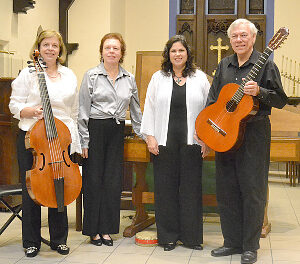The first concert of the season by the Chamber Orchestra of the Triangle was aptly titled “Masters of Invention.” It featured three composers known for their inventiveness: Joseph Haydn (1732-1809), Robert Schumann (1870-1856), and Dimitri Shostakovich (1906-1975).
The concert opened with COT assistant director Niccoló Muti on the podium, leading a spritely performance of Haydn’s Symphony No. 94 in G (“Surprise”). It is probably his best-known work, due to the easily remembered theme in the second movement and the sudden fortissimo chord following the pianissimo repeat – and the often-told account of audiences dozing off. It is a fine example of Haydn’s sense of humor, intimate relationship with his employer, and clever ways of communicating with his audiences. Throughout his 104 recognized symphonies, he regularly worked out new solutions to the challenges of the symphonic form. The COT delivered a sensitive performance, responsive to Haydn’s inventiveness – noteworthy, for example, was the change from the first movement Adagio in 3/4 time to the Vivace assai in 6/8. Phrases were beautifully shaped, dynamics were well-balanced, and the ensemble was crisp and clean.
The featured soloist was the brilliant young Swiss cellist Sayaka Selina. She started playing the cello at age 6. At age 15 she was admitted to the Hochschule für Music Basel and graduated with honors in 2011. Her solo debut was at age 15 with the Zurich Chamber Orchestra and she has since appeared with orchestras and chamber ensembles around the world.
Schumann’s Cello Concerto in A minor was composed in 1850 during a period when he was focused and full of energy and also produced his Third Symphony “Renish.” It was a period of personal reinvention during which he sought new approaches to familiar forms. The Cello Concerto is in three movements performed without pause. It was intended not as a virtuoso showpiece for the soloist, but rather as an interpretive and introspective challenge. The theme, based on Clara’s name, is heard in all three movements, thus implying a tribute to his wife. After reading through the work with Christian Reimers, the principal cellist of the Düsseldorf Orchestra, Clara wrote in her dairy: “I have played Robert’s Violoncello Concerto through again, thus giving myself a truly musical and happy hour. The Romantic quality, the vivacity, the freshness and humor, also the highly interesting interweaving of violoncello and orchestra are indeed wholly ravishing, and what euphony and deep feeling one finds in all the melodic passages!”* Selina’s reading of the score, along with the COT under the direction of Lorenzo Muti, was the embodiment of Clara’s experience – technically unassailable, intimately revealing, and passionately communicated.
After intermission, the scheduled work was Dimitri Shostakovich’s Symphony No. 9, in E-flat. Originally referenced as a grand work with chorus and soloists in praise of the heroic spirit of the Russian people and their victory over Nazi Germany, what was presented in 1945 could hardly have been more different. The work is largely playful, airy and light in nature.
The Ninth is sometimes called Shostakovich’s Classical symphony because of its brevity, form, and frequent chamber character. The Classicism is most apparent in the first movement, which follows 18th-century sonata form right down to repeating the exposition (the only Shostakovich Symphony that does). The movement is a spirited, sassy gallop with touches of slapstick, most memorably the trombone’s repeated mini fanfare (G to C) that both heralds and interrupts the piccolo’s statement of the second theme. The second movement begins with a rather pathos-driven clarinet solo. Gradually a second clarinet and other woodwinds join in. The music becomes more tense and builds to a climax then fades away to the return of the opening melody, this time by the flute. The third movement begins with a fast and cheerful theme by the solo clarinet which seems to be getting more and more crazy, spinning out of control and in danger of falling apart. It slowly fades little by little and merges into the fourth movement. The fourth movement contains what Mravinsky called the “genuine lyricism and profound sorrow” which he saw as slipping into the “unjustified merriment of the finale.” The finale ends with a bitingly satirical version of the main theme played at a Vaudeville-like break-neck presto.
There is a great deal of solo work from tuba to piccolo. It could have been called a concerto for orchestra as well as a symphony. The COT was brilliant this afternoon – individually, as soloists, as part of an ensemble of two or three instruments, or as part of the grand ensemble that is a symphony orchestra.
This Ninth Symphony is an intimate and personal work of art. It is not the celebration of victory that was expected. Shostakovich admitted later that he just could not write a paean for Stalin and his army when all the signs indicated that the brutality was growing worse after the struggle with the Nazis was over. So, he wrote this slapstick satire, holding up a mirror to the demonic outrageous nature of those men who ruled Russia at that time. It stands as a tribute, not to Stalin or his regime, not to the heroic and long-suffering Russian people, but to this one masterful, inventive and brave composer.
All hail to all who put this concert together and brought it to life for their inventiveness and dedication.
*From the excellent program notes written by Jung-Min Mina Lee, Music Department, Duke Univ.











